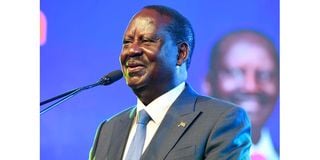Raila’s ‘Mandela moment’ a precursor to ‘Third Liberation’

Azimio la Umoja One Kenya Coalition party presidential flagbearer Raila Odinga.
Kenya is on the cusp of a ‘Third Liberation’. Owing to the influence of his legacy and thoughts on the Kenyan power elite, former South African president, Nelson Mandela, is becoming the patron saint of the ‘Third Liberation’ ideology ahead of the make-or-break August 9, 2022 General Election.
His moral vision, public persona and thoughts on liberation and governance are fundamentally shaping the political ideology of former Prime Minister Raila Odinga’s Azimio la Umoja One Kenya Coalition Party and propelling its 2022 campaign.
The idea of ‘third liberation’ is more than a hype. In their book, Africa's Third Liberation: The New Search for Prosperity and Jobs (November 27, 2012), Greg Mills and Jeffrey Herbst rightly cast the ‘third liberation’ as a sequel to Africa’s two earlier liberations: the first from colonial and racist regimes and the second from post-colonial autocrats.
The third liberation is about putting society on an even moral keel. It is about extending “the arc of the moral universe” and bend Kenya’s capitalist market and democracy toward equity and accountability and justice by reengineering political economies to end corruption, crony capitalism, rent-seeking, elitism and social inequality in order to open up the economic space for wealth creation.
The third liberation “must put us in the driving seat of the Fourth Industrial Revolution in Africa”, Odinga declared on December 10, 2021.
Political ideology
Azimio cannot realise the ideals of the third liberation without a cohesive set of beliefs about politics, public policy, and the role of government or political ideology – the missing link in Kenya’s democracy.
In Kenya, “political parties have no ideology, philosophy, policies or programmes”, goes a tweet by one political pundit.
“What distinguishes one party from another is the ethnicity of the party leader,” he adds.
But a quick glimpse of the four parties whose presidential candidates and their running mates were cleared by the Independent Electoral and Boundaries Commission (IEBC) to run for the August polls reveals that Kenya’s 2022 ideological landscape is changing fast.
Deputy President William Ruto’s United Democratic Alliance/Kenya Kwanza Alliance typifies the radical far left ideologies that advocate sweeping changes. Over the past four years, Ruto, to his credit, has shifted the axis of electoral competition from ethnic politics to a new political dynamic based on class populism.
The 2022 elections is framed as a struggle of apocalyptic proportions between ‘hustlers’ (Ruto) and ‘dynasties’ – mainly the families of friends-turn-foes, including incumbent President Uhuru Kenyatta and Odinga.
George Wajackoyah’s Roots Party blends populism with extreme far-right ideas that advocate going back to the ‘good old days’. While drawing heavily from Rastafarianism, the economic strategy of his cultural populism is to “use marijuana and snake farming to raise capital” to offset Kenya’s debts and put money in the pockets of the youth.
David Mwaure Waihiga’s Agano Party prioritises the fight against corruption, conforming to liberal ideologies that promote gradual change and social welfare of citizens.
Against this backdrop, Odinga’s Azimio is crafting a coherent political ideology and programme to counter adversarial ideologies, to underpin the fourth and final phase of Kenya Vision 2030, develop Kenya Vision 2063 as a successor economic blueprint and deliver on the ‘third liberation’ agenda.
Odinga is pursuing a ‘big tent’ strategy that blends liberal, moderate and a tinge of conservative ideologies and African traditions to manage the diverse interests, influences and ideological hues in Azimio. The party is tapping deep into Mandela’s rich legacy, public persona, thoughts and political ideology to deliver on its ‘Third Liberation’ agenda.
At a personal level, Odinga has been a great admirer of Mandela. “Meeting and shaking hands with Mandela was like shaking hands with history,” he once said. Odinga named his daughter, born in 1990, after Mandela’s wife Winnie, a freedom fighter in her own right. Today, a large portrait of Mandela hangs imposingly on the wall of Odinga’s Capitol Hill office. Odinga represented Kenya at Winnie Mandela's funeral in April 2018.
Within Azimio, pundits have likened Odinga to Mandela. “Raila Odinga is our Mandela”, declared Prof Makau Mutua in an article on February 21, 2022. Owing to his own struggle, imprisonment and suffering during Kenya’s second liberation, Odinga’s own life has idyllic echoes in Mandela’s “Long walk to freedom”. The reconciliatory handshake with President Uhuru Kenyatta on March 9, 2018 buttressed Odinga’s public persona as Kenya’s Mandela. In the aftermath of the handshake, Odinga was hailed as the ‘Mandela of Kenya’.
Freedom is coming
After Odinga unveiled Karua as his running mate on May 21, the Odinga-Martha ticket has ushered in Kenya’s ‘Mandela moment’. Social media platforms are awash with clips of Ms Karua as “Sarafina: Freedom is coming tomorrow,” the 1992 South African musical that followed the release of Nelson Mandela.
Mandela’s thoughts on liberation are driving Azimio’s ‘Third Liberation’. There are striking similarities between Odinga’s political career path and that of Mandela, which morphed through a path of non-violence, violence and finally settled for a non-violent approach to negotiation and reconciliation.
Mandela’s economic thought on the welfare state seems to be is driving Azimio’s third liberation agenda.
Slaying the hydra of corruption is the ultimate test for Azimio’s third liberation agenda.
Prof Kagwanja is a former government adviser, now CEO, Africa Policy Institute ,and Adjunct Scholar, the University of Nairobi and National Defence University-Kenya





